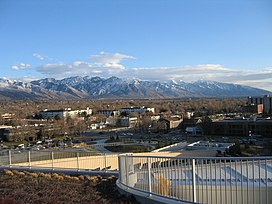
Back سلسلة جبال واساتش Arabic سلسلة جبال واساتش ARZ Уосач Byelorussian Уосач Bulgarian Serralada Wasatch Catalan Wasatch Range CEB Wasatch Range Czech Wasatch Range Danish Wasatchkette German Cordillera Wasatch Spanish
| Wasatch Range | |
|---|---|
 View of the Wasatch Range from the Salt Lake City Public Library, January 2006 | |
| Highest point | |
| Peak | Mount Nebo |
| Elevation | 11,928 ft (3,636 m) |
| Geography | |
| Country | United States |
| States | Utah and Idaho |
| Range coordinates | 40°29′24″N 111°41′46″W / 40.49000°N 111.69611°W |
| Parent range | Rocky Mountains |
The Wasatch Range (/ˈwɑːsætʃ/ WAH-satch) or Wasatch Mountains is a mountain range in the western United States that runs about 160 miles (260 km) from the Utah-Idaho border south to central Utah.[1] It is the western edge of the greater Rocky Mountains, and the eastern edge of the Great Basin region.[2] The northern extension of the Wasatch Range, the Bear River Mountains, extends just into Idaho, constituting all of the Wasatch Range in that state.
In the language of the native Ute people, Wasatch means "mountain pass" or "low pass over high range."[3][4] According to William Bright, the mountains were named for a Shoshoni leader who was named with the Shoshoni term wasattsi, meaning "blue heron".[5] In 1926, Cecil Alter quoted Henry Gannett from 1902, who said that the word meant "land of many waters," then posited, "the word is a common one among the Shoshones, and is given to a berry basket" carried by women.[6]
- ^ "Wasatch Range". Geographic Names Information System. United States Geological Survey, United States Department of the Interior.
- ^ Hiking the Wasatch, John Veranth, 1988, Salt Lake City, ISBN 978-0-87480-628-1
- ^ Fuller, Craig. "Wasatch County". Utah History Encyclopedia. Archived from the original on 9 February 2019. Retrieved 24 March 2019.
- ^ Van Cott, John W. (1990). Utah Place Names: A Comprehensive Guide to the Origins of Geographic Names: A Compilation. Salt Lake City: University of Utah Press. p. 390. ISBN 978-0-87480-345-7. OCLC 797284427. Archived from the original on 3 June 2024. Retrieved 24 March 2019.
- ^ Bright, William (2004). Native American Placenames of the United States. Norman, Oklahoma: University of Oklahoma Press. p. 549. ISBN 978-0-8061-3598-4. Archived from the original on 3 June 2024. Retrieved 22 November 2015.
- ^ Salt Lake Tribune, 16 May 1926
